Fed Plays Russian Roulette with US Dollar - Stoking the Fires of Stagflation
Currencies / US Dollar Jan 16, 2008 - 04:41 PM GMTBy: Gary_Dorsch

 In an age where governments of every political stripe distort data to promote their own self interests, it's hardly surprising that they present inflation data in a manner that is best suited to their particular needs. By the same token, it's entirely natural for official inflation data to be wildly at odds with the reality that is faced by consumers and businesses, and to be regarded with utter disbelief.
In an age where governments of every political stripe distort data to promote their own self interests, it's hardly surprising that they present inflation data in a manner that is best suited to their particular needs. By the same token, it's entirely natural for official inflation data to be wildly at odds with the reality that is faced by consumers and businesses, and to be regarded with utter disbelief.
So it wasn't shocking to hear Federal Reserve officials insist last week, that inflation in the United States is under control, before telegraphing another tidal wave of liquidity injections into the US economy in the months ahead. “Stable inflation expectations give the Fed a lot of room for maneuver. If the evidence suggests that substantial policy easing is appropriate, I don't think we're going to face a risk of adverse inflation consequences,” said St Louis Fed chief William Poole on Jan 9th.
In an election year for the highest office in the land, American politicians from both sides of the isle, are quick to propose all kinds of fiscal stimulus and pork barrel projects to jump start the sputtering US economy. But adding more monetary stimulus to the mix has the potential to ignite hyper-inflation in the US economy, and a speculative attack on the US dollar in the $3.2 trillion a day currency market. “It's difficult enough to make good policy in a complex economy and complex financial system,” said Fed chief Ben “B-52” Bernanke on January 11th. “Political considerations will play no role, and I assure you as strongly as I can, that we will be objective and analytical, and we'll do what's right for the economy,” he said.
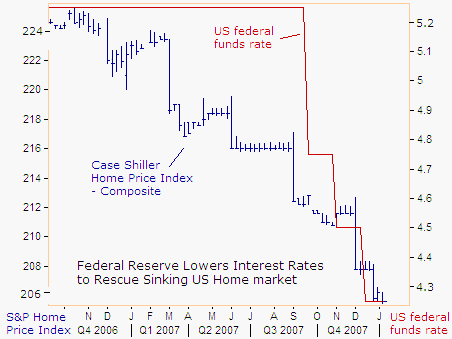
It's now becoming increasing clear, that the only prices the Fed is focusing on these days are home prices and those for toxic sub-prime mortgage debt. The Fed is pegging the federal funds rate in the direction of US home prices, mimicking the Bank of England as an asset targeter. Last week, nearby futures contracts on the Standard & Poor's/Case-Shiller, an index of home prices in the top-10 US cities, fell below the 206-level, or roughly 7% lower from a year ago.
Robert Shiller, a Yale University economist, and co-founder of the widely watched house-price index, predicted on Dec 31st, a possibility that the US economy would stumble into a Japanese-style recession, with house prices declining for years. “American real estate values have already lost around $1 trillion. That could easily increase threefold over the next few years. This is a much bigger issue than sub-prime. We are talking trillions of dollars' worth of losses.”
He noted that Chicago futures markets are pricing in further declines in US home prices, with farther dated contracts on the S&P Shiller Index pointing to losses of up to 14 percent. In the third quarter of 2007, US homeowners withdrew $20 billion less in equity from their homes than in the prior quarter, and since housing prices have continued to tumble, the outlook for cash-outs has continued to dim.
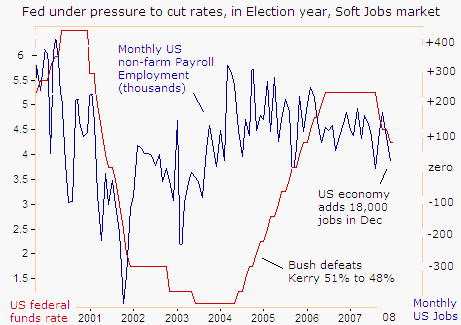
Lenders have also grown more cautious in handing out cash through home equity lines of credit since those loans were failing at their highest rate in ten years during the third quarter. If the housing market continues to sink this year, consumers will have less home equity to convert into cash, which could lead to a big pullback in spending. With consumers struggling with high energy costs and a softening jobs market, the drying up of home equity could usher in an economic recession.
Slumping home prices and a softer jobs market, could increase foreclosures on many sub-prime home borrowers, and blow huge craters in the balance sheets of banks and brokers worldwide. Credit Suisse projects 775,000 homes with $143 billion of mortgage debt will go into foreclosure in the next two years. Goldman Sachs estimated that losses in mortgage markets worldwide may reach $726 billion.
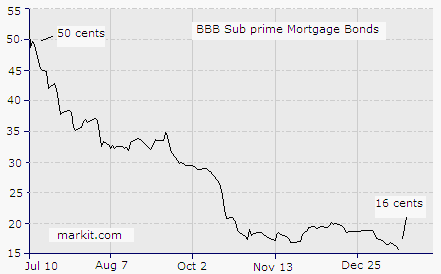
Some BBB rated sub-prime mortgage bonds have already tumbled to 16-cents on the dollar from 50-cents last July. AA rated paper isn't faring much better, fetching only 40-cents in the $1.8 trillion sub-prime mortgage market. On January 15th, Citigroup C.n, the nation's largest bank, took a fourth-quarter loss of nearly $10 billion, stemming largely from $18 billion of write-downs of sub-prime mortgages.
The deepening gloom in the US financial sector came as Bank of America BAC.n agreed to acquire battered mortgage lender Countrywide Financial CFC.n for $4 billion, to avert one of the biggest collapses due to the toxic sub-prime debt bomb. Merrill Lynch is expected to suffer $15 billion in losses stemming from soured mortgage investments, as the sub-prime debt bomb goes nuclear.
Bernanke Signals more Rate cuts in Q'1
With the US economy sinking deeper into the “Stagflation” trap, and credit worries clogging the arteries of the Libor market, Mr Bernanke shouted loud and clear for the whole world to hear on Jan 10th, that the Fed and the US Treasury (the “Plunge Protection Team” - PPT) have decided to exercise the “Greenspan Put” option, and will simply disregard elevated inflationary pressures in the rest of the economy.
“In light of recent changes in the outlook for and the risks to growth, additional policy easing may be necessary,” Bernanke said on January 11th. “We stand ready to take substantive additional action as needed to support growth and to provide adequate insurance against downside risks. Inflation expectations are reasonably well anchored,” and he pledged to monitor inflation expectations closely.
For the PPT, the devil of hyper-inflation is preferable to the specter of a bear market for the Dow Jones Industrials and weaker home prices. Exercising the “Greenspan Put,” means the Fed will slash the federal funds rate far below the US inflation rate in the months ahead. But that's a frightening prospect for foreign holders of $2.3 trillion of US Treasury debt, who must contend with negative interest rates, which in turn, could severely weaken their US dollar denominated investments.
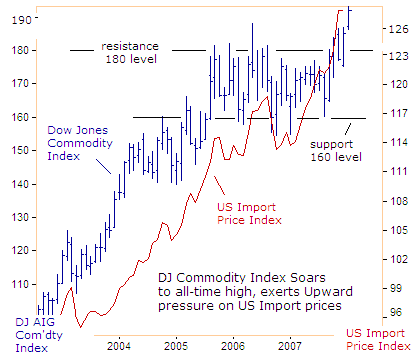
The Fed is signaling aggressive rate cuts at a dangerous time. Inflationary pressures in the US economy are elevated at multi-decade highs. US producer prices were up +6.3% last year, and US consumer prices up +4.1%, the highest in 17-years, compared with +2.5% for 2006. Gasoline costs were up 37%, and food prices were up 9.3% last year, embedding inflation fears into the American psyche.
Thanks to the Fed's cheap dollar policy, US import prices rose +10.9% in 2007, the largest calendar-year increase since 1987. The Dow Jones AIG Commodity Index soared to an all-time high of 193.25, exerting upward pressure on raw material costs.
Only one lone voice of reason from Foggy Bottom is advising caution. “I would be very careful, not to let inflation accelerate too long,” warned Kansas City Fed chief Thomas Hoenig on January 10th. But Hoenig was rotated off the Fed's interest rate setting committee, after he dissented against a rate cut in October, in favor of keeping Fed policy on hold. Instead, the politically correct thing to do in Washington these days is to cut rates and drop dollar bills across America from helicopters and B-52 bombers.
The Fed's big Gamble
The Fed is betting that a sharp slowdown in the global economy will weaken commodity prices, and that Saudi Arabia will pump more oil, to keep inflationary pressures at bay. Until now, the Fed's rate cutting campaign, its special $80 billion liquidity injection scheme and promises of another big tidal wave of liquidity, have severely weakened the value of the US dollar, which in turn, fueled parabolic rallies in crude oil and precious metals to all-time highs.
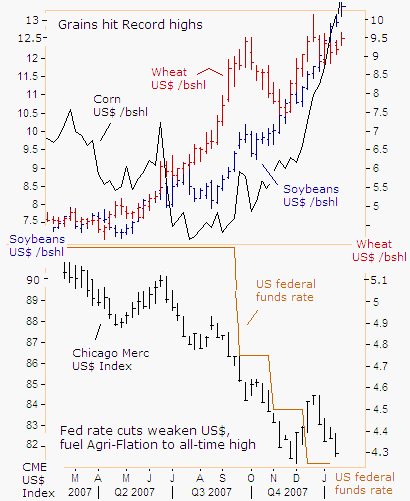
Fed rate cuts also fueled Agri-flation worldwide. In Chicago, March wheat jumped the to $9.40 /bushel, after the USDA reported smaller than expected US plantings for hard red winter wheat. Corn surged to an 11-year high of $5.15 /bushel, on a big drawdown in US corn stocks. July soybeans soared to $13.76 a bushel, buoyed by fears that corn's surge could cut into soybean plantings for 2008.
Rough rice futures in Chicago hit an all-time high of more than $15 per hundredweight, 37% higher from a year ago. Egypt is a major exporter of rice, but has suspended exports indefinitely, due to hoarding and speculation in its local economy. In Pakistan, armed guards escort trucks carrying high-prized wheat. India will become a net importer of rice this year, for the first time.
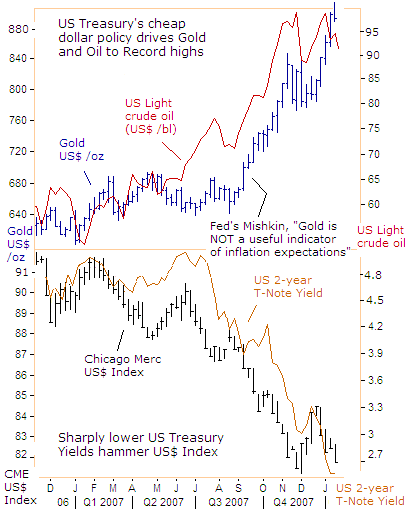
Jordan intends to double the stocks of wheat inside its country to 390,000 tons, equivalent to six months of supply, plus a further 130,000 tons purchased and being shipped, representing two months of supply. Doubling wheat stocks is an indication that some major importers see no end to the bull market in Chicago and want to protect themselves. Ocean shipping costs for dry goods have fallen 35% in recent weeks, which may encourage more purchasing of grains.
Bush Seeks Quick Fix to Tame Oil prices
On his arrival in Riyadh on January 15th, President Bush urged Saudi king Abdullah to put more crude oil on the world market, warning that soaring prices could cause an economic slowdown in the United States, and weaken the housing market. “High energy prices can damage consuming economies. When consumers have less purchasing power, it could cause the economy to slow down. I hope OPEC nations put more supply on the market. It would be helpful,” he said.

Saudi Arabia is the only member of OPEC with spare capacity - roughly 2.8 million barrels per day. Saudi Oil chief Ali al-Naimi said on Jan 15th, that Riyadh is ready to boost oil output if the market needed more oil to tame high prices. "Nobody would look with pleasure on a recession in the United States. Concerns about US economic growth are valid. But the price of oil is more than just the US economy. Global economies are growing despite oil prices ranging between $90 and $100 a barrel,” Naimi said. For instance, China's oil imports rose 12% last year to a record 3.26 mil bpd.
 But al-Naimi also blamed speculators in London and New York for inflating the price of crude oil by $20 to $30 per barrel. “Twenty to thirty dollars is the outside influence on the price of oil. If you look at who's in the market, you'll find a lot financial institutions are speculating, using the market as a hedge.” Still, Naimi wouldn't say if Riyadh would agree to boost oil output at OPEC's Feb 1 meeting.
But al-Naimi also blamed speculators in London and New York for inflating the price of crude oil by $20 to $30 per barrel. “Twenty to thirty dollars is the outside influence on the price of oil. If you look at who's in the market, you'll find a lot financial institutions are speculating, using the market as a hedge.” Still, Naimi wouldn't say if Riyadh would agree to boost oil output at OPEC's Feb 1 meeting.
King Abdullah must walk a along a tightrope, balancing his military patron's request for more oil, against Iran's opposition to further increases in output, which could hurt Tehran's oil revenue. On Dec 5th, Iran's President Mahmoud Ahmadinejad scored a big victory, when he convinced king Abdullah to join the hawks of OPEC – Iran, Libya, and Venezuela, and hold the cartel's oil output steady at 27.25 million bpd. “Our position is that demand and supply are balanced and there is no need to increase oil to the market,” said Iranian Oil Minister Gholamhossein Nozari. Still, the key question is which way will Saudi oil policy lean at the upcoming Feb 1st meeting in Vienna, in favor of US Prez Bush or Iran's Ahmadinejad?

However, Riyadh is keen to keep oil prices elevated within a higher target zone, to sustain the enormous flow of petro-dollars to the Gulf, which has revived the speculative appetite for the local stock market. The Saudi All Share Index hit the psychological 12,000 barrier last week, enriching the brokerage accounts of 7,000 Saudi princes, who control 70% of the market.
Beijing warns US Treasury against further Fed rate cuts
Beijing also finds itself in a tough predicament, with $1.53 trillion of foreign exchange reserves over the past five years, mostly stockpiled in depreciating US dollars. However, Chinese leaders finally woke up to the folly of such a foolish investment policy. “The world's currency structure has changed,” declared Xu Jian, vice director of the People's Bank of China (PBoC) on Nov 7th.
“The US dollar is losing its status as the world reserve currency,” he warned. “We will favor stronger currencies over weaker ones, and will readjust accordingly,” added Cheng Siwei, vice chairman of China's National People's Congress. On Dec 27th, Hu Xiaolian, director of China's Foreign Exchange department, wrote, “If the US federal funds rate continues to fall, this will certainly have a harmful effect on the US dollar exchange rate and the international currency system,” he said.
Traders closely watch any change in China's strategy which could affect exchange rates. China's central bank is tightening its monetary policy to combat inflation, which is raging ahead at a 6.5% annualized rate. At the same time, the Bernanke Fed is preparing to flood global money markets with another tidal wave of cheaper US$'s. China raised benchmark interest rate six times in 2007, but the benchmark one-year deposit rate of 4.14% is still far lower than the inflation rate.
“We must be sure about one thing, the central bank is moving towards the objective of positive real interest rate instead of moving away from it, “said Yu Yongding, a key advisor to the PBoC, on Janaury 3rd. The next day, the PBoC vowed to further tighten monetary policy in 2008, aiming in particular to prevent inflation from moving from certain sectors to the broader economy.
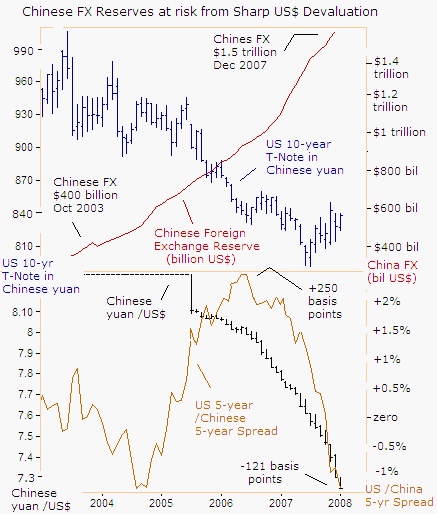
A year ago, the US Treasury's 5-year T-note was yielding +2% more than China's 5-year note. But today, the US T-note yields -1.2% less, putting enormous downward pressure on the US$ /Chinese yuan, and cementing big foreign currency losses in Beijing's portfolio of US bonds. According to forward traders in Hong Kong, the dollar is expected to fall another 9% to 6.6-yuan over the next 12-months.
Since March 2006, China has been a net seller of US Treasury debt, reducing its exposure from $421 billion to $386.7 billion in November, and seeking to avoid further losses on the dollar's exchange rate with the yuan. “The weakening dollar and rising global commodity prices is also creating inflationary pressures for China, but a quicker appreciation of the yuan would probably help offset some of those price increases,” said Yao Jingyuan, chief economist of the state statistics agency.
On Jan 16th, the PBOC hiked bank reserve requirements by 0.50% to a record 15%, a move that will drain 200 billion yuan ($28 billion) from the Shanghai money markets. The dollar fell to 7.23 yuan, or -3.2% lower since late October, a faster decline than the -1.2% slide in the US Dollar Index over same period, meaning the yuan is rising at an even faster pace against a basket of six major global currencies, including the Euro, British pound, and Canadian dollar.
Arab Oil kingdoms are Saviors of US$,
Japan is the largest holder of US Treasury debt, but has been a net seller of $46 billion, and South Korea has sold $19 billion over the past 12-months. To pick-up the slack, the Bush administration has relied heavily on the Arab Oil kingdoms, to recycle their bulging petro-dollar surpluses back into US Treasury debt. Since 9/11, America has assumed the financial costs of occupying Iraq, while the Arab oil kingdoms have experienced a staggering infusion of new wealth.
Saudi Arabia has taken in nearly $900 billion in oil revenues over the last six-years, and the emirate of Abu Dhabi has a sovereign wealth fund approximating $1 trillion. There had been a time, in the lean 1990's, when Saudi Arabia's debt had reached 120% of Saudi GDP, but today it has fallen to 5 percent. And from a year ago, it is estimated that the Arab oil kingdoms have recycled as much as $227 billion into US Treasuries, mostly through their brokers in London.
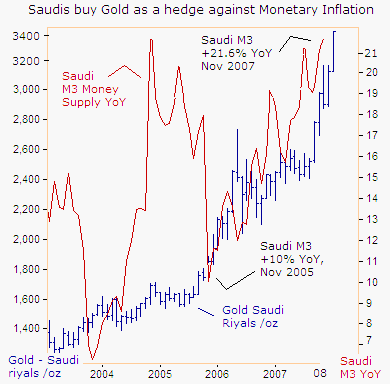
In order to keep the archaic dollar /riyal peg intact, the Saudi central bank has more doubled the growth rate of its M3 money supply to 21.6%, to stay ahead the of Bernanke Fed's 16% expansion of the US M3 money supply. The Saudi central bank has cut its key repurchase rate, the benchmark for deposits, to 4% in tandem with the Fed. But the rapid growth of the money supply pushed Saudi inflation to 6% in October, it's highest since 1995. Food price inflation hit 7.5 percent.
Inflation in four of the six Gulf Arab oil kingdoms has overtaken official lending rates, encouraging speculation in real estate, which is the main cost of living across the region. Saudis blame King Abdullah's insistence on pegging the riyal to the US dollar for higher inflation at home. The central bank is handcuffed in the fight against inflation by the riyal's peg to the dollar, which forces it to track US monetary policy at a time when the Federal Reserve is cutting interest rates.
Those who can afford to buy gold have protected their wealth from the Saudi central's banks' money spigots. But most of the Saudi population hasn't been so fortunate. “We remind you of Prophet Mohammad's words that you are shepherds who are responsible for your flock,” said 19 well-known clerics, including Nasser Al Omar, on Dec 16th. “The rulers should seek to try to remedy this crisis in a way that would ease people's suffering. This crisis will have a negative impact on all levels, causing theft, cheating, armed robbery and resentment between rich and poor.”
Bush offers $20 billion arms deal for Saudi Oil
In a keynote speech in Abu Dhabi on January 13th, US President George Bush reminded the leaders of the oil kingdoms of what he called the threat to the world posed by Tehran. “Iran seeks to intimidate its neighbors with missiles and bellicose rhetoric, and its actions threaten the security of nations everywhere. So the United States is strengthening our longstanding security commitments with our friends in the Gulf to confront this danger before it is too late,” he warned.
 The underlying message is simple, in return for American military protection against Iran, the Bush clan expects the Arab oil kingdoms to stick with their archaic dollar pegs, and recycle much of their oil surplus into US Treasuries. To keep the Saudi petro-dollars flowing into US Treasury debt, Bush offered Riyadh a $20 billion package of advanced weaponry, to shore up their defenses against Iran.
The underlying message is simple, in return for American military protection against Iran, the Bush clan expects the Arab oil kingdoms to stick with their archaic dollar pegs, and recycle much of their oil surplus into US Treasuries. To keep the Saudi petro-dollars flowing into US Treasury debt, Bush offered Riyadh a $20 billion package of advanced weaponry, to shore up their defenses against Iran.
Still, Saudi Arabia and other Gulf Arab states are looking beyond the last 12-months of the Bush presidency, and are determined to maintain good relations with Iran, which might only be a few years away from acquiring nuclear weapons. “We'll listen to everything the president says. He can raise any issue he likes. We're a neighbor to Iran in the Gulf, which is a small area, so we're keen for harmony and peace among countries in the area,” said Foreign Minister Saud al-Faisal. Saudi Arabia invited Iran's Ahmadinejad to the Haj in Mecca in December and Qatar invited Ahmadinejad to a summit of the Gulf Cooperation Council (GCC) last month.
Bush spoke with the Saudi king in his opulent palace. Its marble floors and walls contain sheets of gold, colored with precious stones and embedded jewels. The king also invited Bush to his lavish horse farm where 150 Arabian stallions are stabled, as a payback to his visit to the Bush ranch in Crawford, Texas.
European Central Bank Rules out Rate cuts
The Bernanke Fed is playing Russian roulette with the US dollar, reckoning that other central banks will eventually join its money printing orgy, to prevent their currencies from rising sharply higher against the greenback. But while the Fed is trying to brainwash the media into believing that inflation is under control, ECB chief Jean “Tricky” Trichet has flatly ruled out any Euro rate cuts in the months ahead, arguing that inflation is a major threat faced by the Euro zone.
On Jan 10th, Trichet was asked whether it was correct to say the ECB had a bias to tighten rates, “We are certainly not neutral,” warning the ECB is not prepared to tolerate a wage-price spiral triggered by higher food and oil prices. Speaking on French television on January 14th, Trichet rebuffed suggestions by French government officials, that the ECB should pay more attention to stimulating growth, like the Federal Reserve, rather than focusing on keeping inflation under control.
“There is not one European to say that now is the moment to be particularly lax in the matter of fighting inflation,” Trichet declared. ECB member Michael Bonello backed his new boss, “The bank remains prepared to act to insure that the upside risks to price stability, which are clearly mounting at the moment, do not materialize,” he said. Austrian central bank chief Klaus Liebscher added, “We have clear upward risks from inflation, $95 per barrel of oil and dramatic food price increases. On top of this, we could see second round effects,” he said.
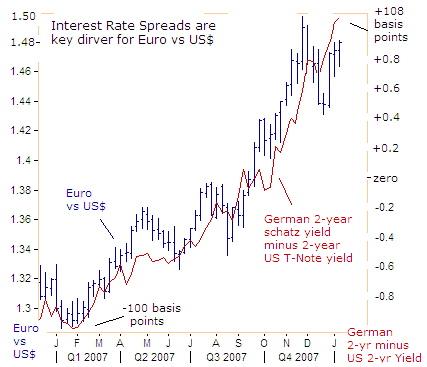
Compared to the reckless amateurs at the Federal Reserve, ECB officials are sounding more responsible and like stalwart guardians of the Euro's purchasing power. But one must also keep in mind, that the ECB is inflating its M3 money supply at a record 12.3% annual rate. In doing so, the ECB has been a major accomplice to the historic rally in food and energy prices over the past few years.
The ECB is now warning Euro zone workers to avoid asking for higher wages, which they seek to compensate for the inflation that was created by the central bank itself. “Wages must not seek to catch up with prices to compensate for a weakening in purchasing power following this price rise,” warned Italy's central bank chief Bini Smaghi on Jan 14th. “Otherwise inflation might not go down and at that point there won't be any other solution than a monetary tightening,” he said.
On January 15th, Bundesbank chief Axel Weber said there were signs that wage pressure and inflation expectations were starting to drift up. “The currently noticeable higher rates of inflation in Germany and the Euro area overall should not be the yardstick for upcoming wage negotiations. We are observing current developments very carefully and, if needed, action will follow our words."
Around 2 million German public sector workers are seeking an 8% increase in wage talks which began last week, while German train drivers have already secured an 11% raise. German union bosses are calling the ECB's bluff, figuring the central bank does not have the green light from government finance officials for a rate hike, given the severity of the credit crunch in the Euro Libor markets.
Bank of Japan is Silent on dollar's Slide to 106-yen
Japan's ministry of finance is the most notorious manipulator of inflation data, and for good reason. Japan's outstanding public debt is 776 trillion yen ($7.25 trillion), or roughly 147% of gross domestic product, the highest among leading industrialized countries. In order to keep its interest rates and debt service costs low, Tokyo's uses fuzzy math to calculate it inflation rate, to provide the Bank of Japan with the political cover to peg its overnight loan rate at an abnormally low 0.50 percent.
Japan imports almost all of its oil, or 4.2 mil bpd, and is the world's third-largest oil consumer after the US and China. Japan runs an industrial economy and is only 40% self sufficient in agricultural commodities, so 60% of its domestic demands for food and agricultural products are imported. Yet Tokyo claims that Japan's consumer price index is only +0.4% higher from a year ago, by far the lowest on the planet, despite a near doubling of food and energy prices from a year ago.
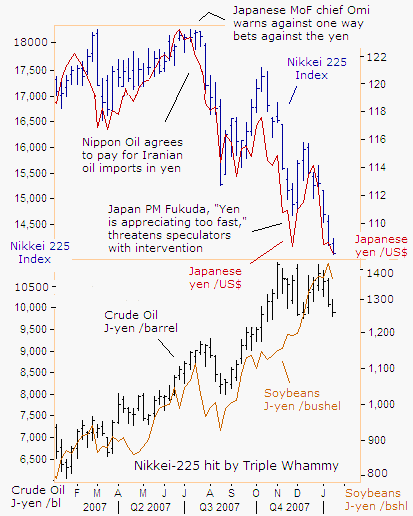
Japan has an enormous stash of cash, and can easily afford to pay for sharply higher prices for food and energy imports. Japan's current-account surplus, the widest measure of a country's financial performance on an international basis, expanded 46% to 2.2 trillion yen ($20.1 billion) in October from a year earlier. Japan's foreign exchange reserves rose 9% to a record $973 billion last year, and are the world's second largest behind China's $1.53 trillion.
Currency traders are attracted to the yen because of Japan's large external surpluses, but are also discouraged from buying the currency, because of abnormally low interest rates for Japanese bonds. On the flip side, global traders have borrowed $1.2 trillion in Japanese yen at 1% or less, to purchase stocks and commodities on worldwide exchanges, popularly known as the ”yen carry” trade.
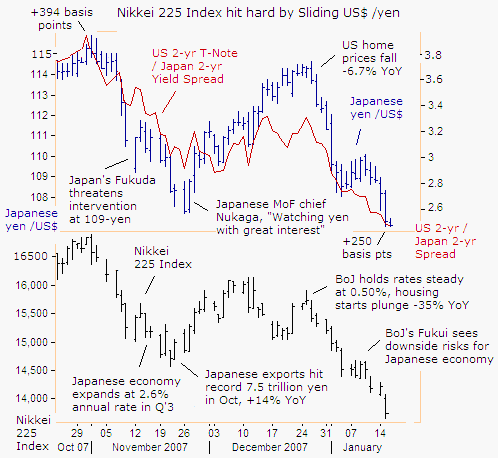
Recently, the US$ has been tumbling against the yen, because the US Treasury's 2-year note yield has plunged from +394 basis points above the Japanese 2-year yield to as low as +250 bp over the past two months. And in a chain reaction, Japan's Nikkei-225 plunged to a 26-month low, as key exporters sank on fears of a possible recession in the US market and the surging yen. A weaker dollar will hurt exporter profits earned in the US, when converted back into yen.
Thus, unilateral Fed rate cuts have become a big headache for Tokyo's financial warlords. Yet Japanese finance officials were surprisingly silent this week, as the dollar fell below 109-yen, previously regarded as the MoF's red line in the sand, where intervention was expected to defend the dollar. The lack of intervention raises the possibility that Tokyo may have acquiesced to a stronger yen, in order to help dampen the high cost of imported food and energy.
Traders might probe the dollar's downside, until subtle threats of intervention are sounded out by the MoF. There is also simmering speculation that the BoJ might lower its overnight loan rate to zero percent, after BoJ chief Toshihiko retires in March. The yield of two-year Japanese government bonds fell to 0.60%, just 10 basis points above the overnight call rate target.
A rate cut to zero percent could raise speculation of the BOJ returning to “quantitative easing”, a policy of force-feeding banks with excess cash to kick-start the economy. Annual growth in Japanese bank lending has slowed to +0.1% from a year ago, indicative of an anemic economy. Odds are rising that the world's second largest economy is slipping into recession, led by weaker exports to the US.
Breakdown of Fiat (paper) Currency System
 In a world of fiat (paper) currency, the full faith and trust in a nation's currency often lies in the policy actions and honesty of its central bankers. Under the Bernanke Fed, global confidence in the US dollar has been badly shaken, and the Fed rookies hand picked by Mr Bush, are just learning about gold's special role in the international monetary markets.
In a world of fiat (paper) currency, the full faith and trust in a nation's currency often lies in the policy actions and honesty of its central bankers. Under the Bernanke Fed, global confidence in the US dollar has been badly shaken, and the Fed rookies hand picked by Mr Bush, are just learning about gold's special role in the international monetary markets.
Trading in the foreign exchange market is akin to a reverse beauty contest, judging the least ugly (least inflated) currency as the winner. So far, only two central banks in Canada and England have shown a interest in joining the Fed's money printing orgy.
Gold cannot be printed and mining output is 9% lower than a year ago. The Bernanke Fed is playing Russian roulette with the greenback, and a serious breakdown of the fiat (paper) currency system might only be a Fed rate cut or two away.
By Gary Dorsch,
Editor, Global Money Trends newsletter
http://www.sirchartsalot.com
To stay on top of volatile markets, subscribe to the Global Money Trends newsletter today, which includes a special bonus for new subscribers, - “Audio Broadcasts”, posted on Monday and Wednesday evenings, during Asian trading hours, to the Log-In section of our website. This article was just the Tip of the Iceberg , of what's inside the Global Money Trends newsletter, published on Friday afternoon. Here's what you will receive with a subscription,
Insightful analysis and predictions of the (1) top dozen stock markets around the world, Exchange Traded Funds, and US home-builder indexes (2) Commodities such as crude oil, copper, gold, silver, the DJ Commodity Index, and gold mining and oil company indexes (3) Foreign currencies such as, the Australian dollar, British pound, Euro, Japanese yen, and Canadian dollar (4) Libor interest rates, global bond markets and central bank monetary policies, (5) Central banker "Jawboning" and Intervention techniques that move markets.
GMT filters important news and information into (1) bullet-point, easy to understand analysis, (2) featuring "Inter-Market Technical Analysis" that visually displays the dynamic inter-relationships between foreign currencies, commodities, interest rates and the stock markets from a dozen key countries around the world. Also included are (3) charts of key economic statistics of foreign countries that move markets.
Subscribers can also listen to bi-weekly Audio Broadcasts , with the latest news and analysis on global markets, and view our updated model portfolio for Q'1, 2008. To order a subscription to Global Money Trends , click on the hyperlink below,
http://www.sirchartsalot.com/newsletters.php
Mr Dorsch worked on the trading floor of the Chicago Mercantile Exchange for nine years as the chief Financial Futures Analyst for three clearing firms, Oppenheimer Rouse Futures Inc, GH Miller and Company, and a commodity fund at the LNS Financial Group.
As a transactional broker for Charles Schwab's Global Investment Services department, Mr Dorsch handled thousands of customer trades in 45 stock exchanges around the world, including Australia, Canada, Japan, Hong Kong, the Euro zone, London, Toronto, South Africa, Mexico, and New Zealand, and Canadian oil trusts, ADR's and Exchange Traded Funds.
He wrote a weekly newsletter from 2000 thru September 2005 called, "Foreign Currency Trends" for Charles Schwab's Global Investment department, featuring inter-market technical analysis, to understand the dynamic inter-relationships between the foreign exchange, global bond and stock markets, and key industrial commodities.
Copyright © 2005-2008 SirChartsAlot, Inc. All rights reserved.
Disclaimer: SirChartsAlot.com's analysis and insights are based upon data gathered by it from various sources believed to be reliable, complete and accurate. However, no guarantee is made by SirChartsAlot.com as to the reliability, completeness and accuracy of the data so analyzed. SirChartsAlot.com is in the business of gathering information, analyzing it and disseminating the analysis for informational and educational purposes only. SirChartsAlot.com attempts to analyze trends, not make recommendations. All statements and expressions are the opinion of SirChartsAlot.com and are not meant to be investment advice or solicitation or recommendation to establish market positions. Our opinions are subject to change without notice. SirChartsAlot.com strongly advises readers to conduct thorough research relevant to decisions and verify facts from various independent sources.
Gary Dorsch Archive |
© 2005-2022 http://www.MarketOracle.co.uk - The Market Oracle is a FREE Daily Financial Markets Analysis & Forecasting online publication.


